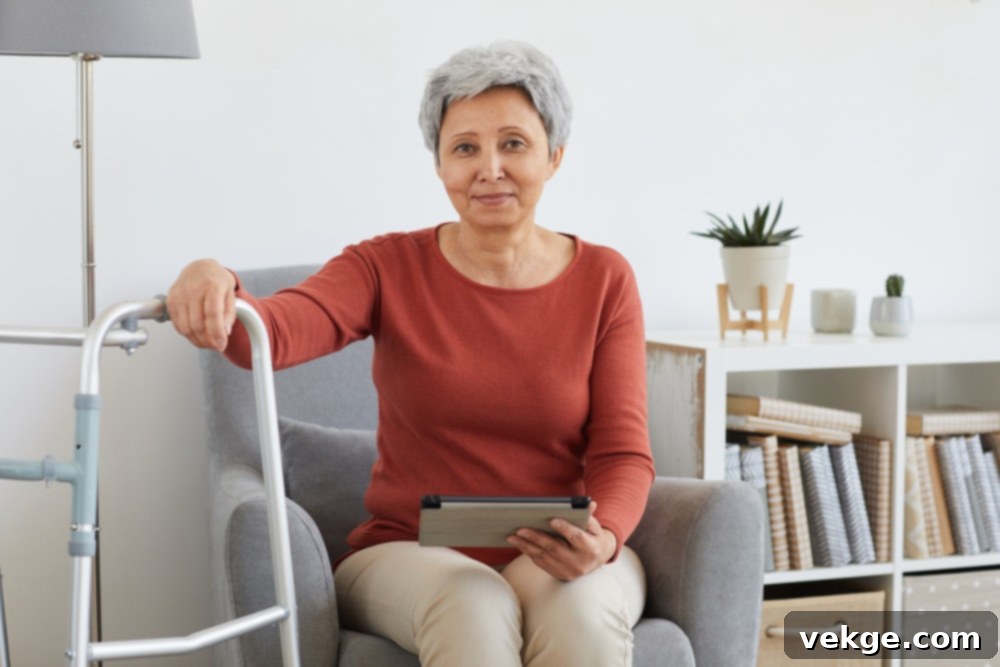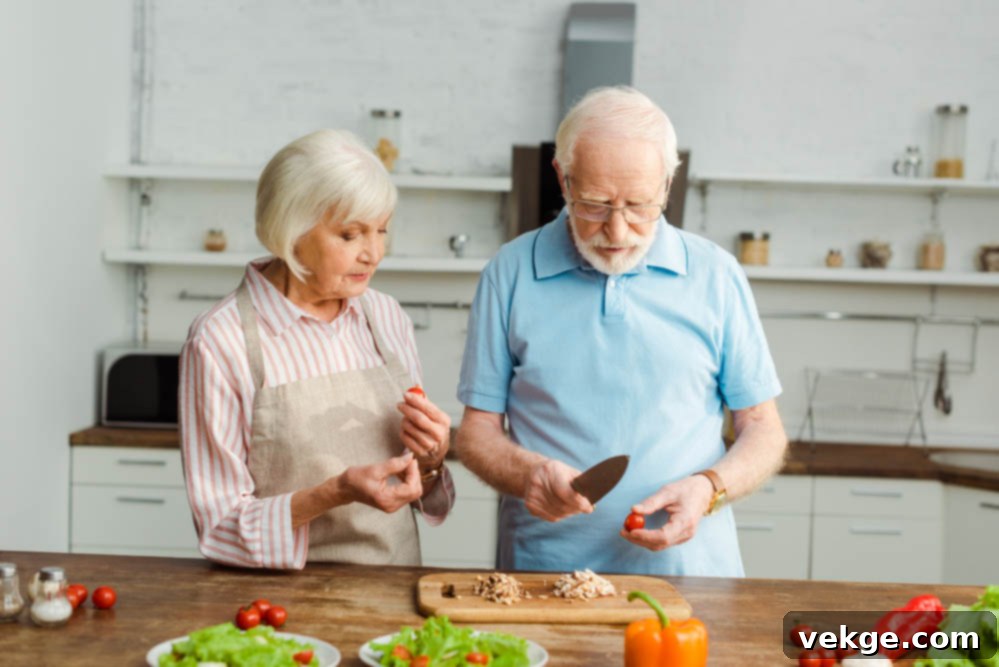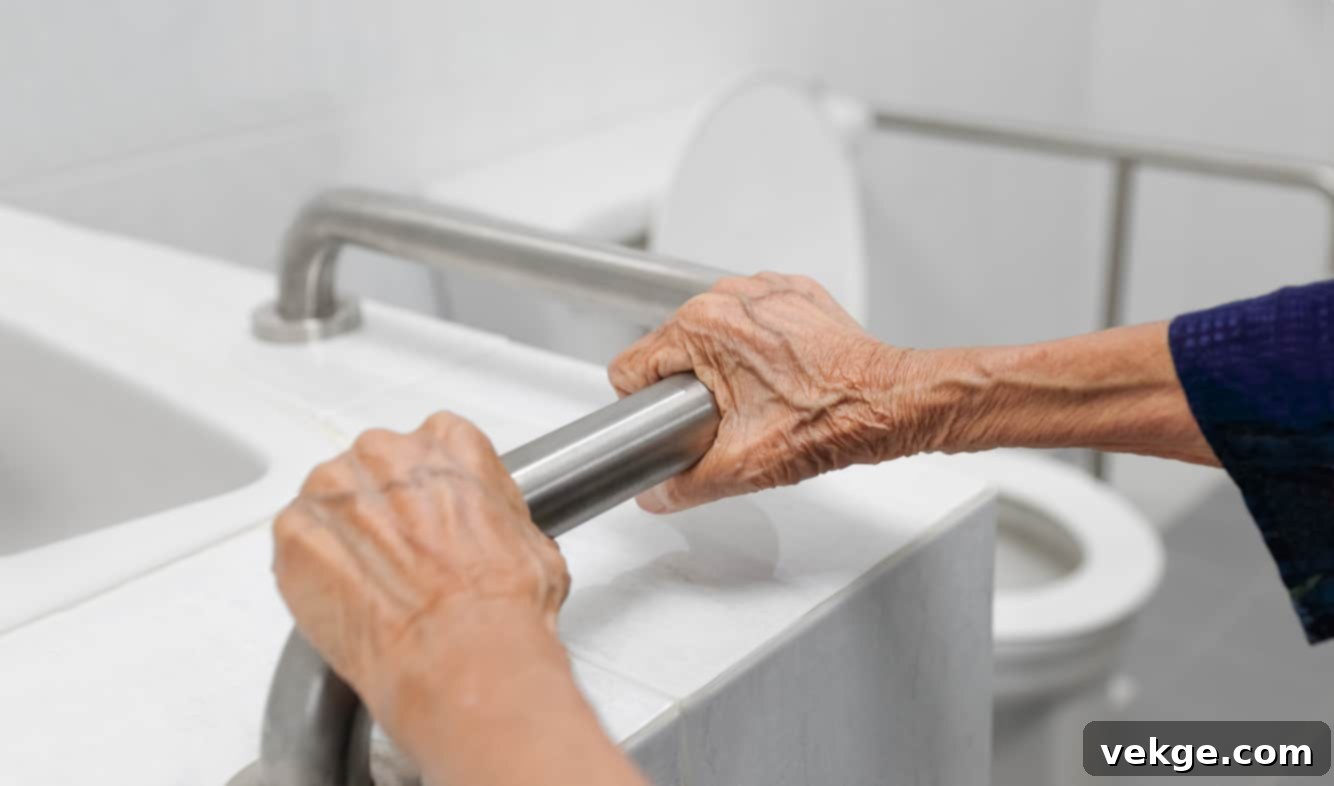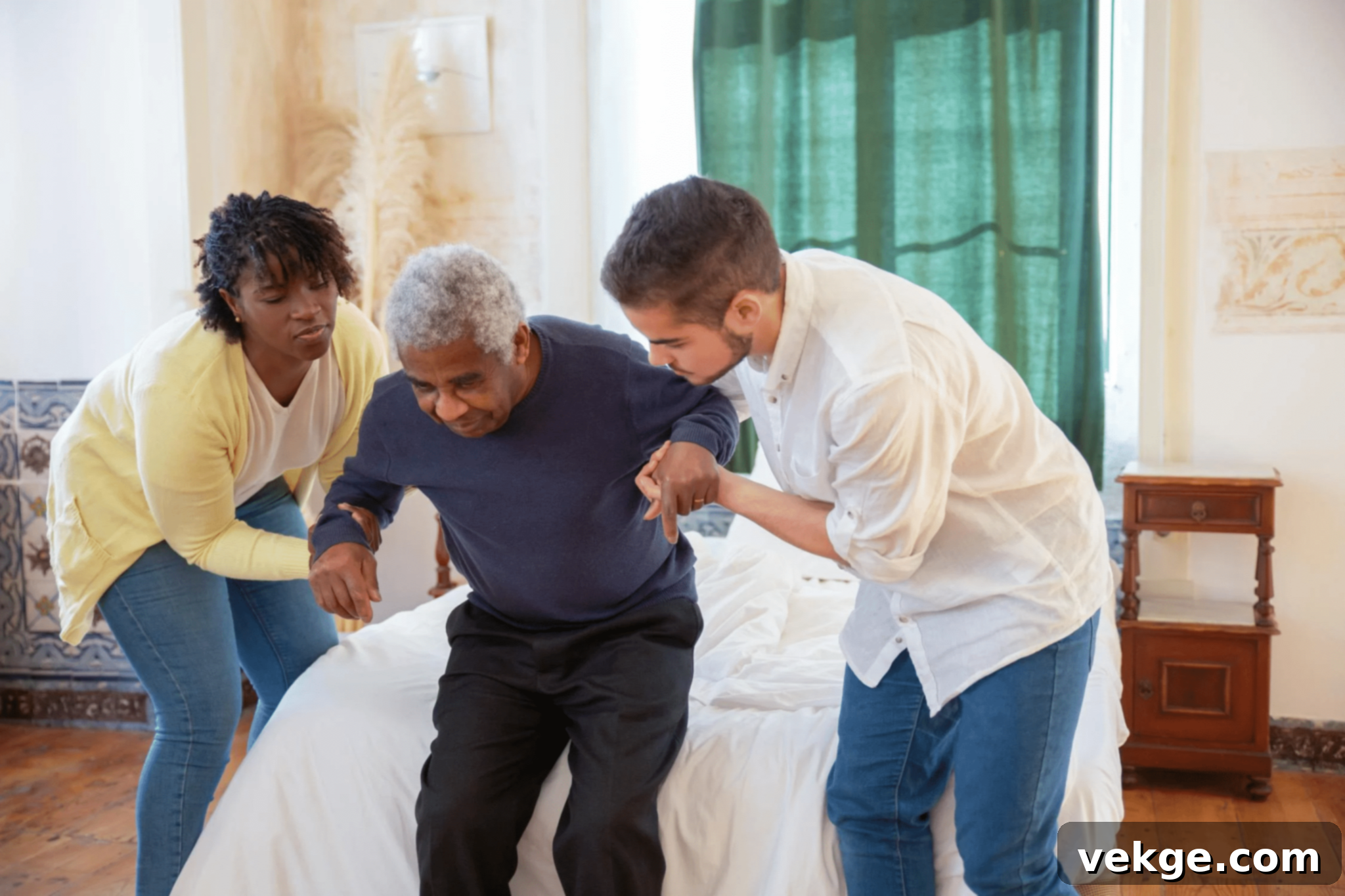The Ultimate Guide to Home Safety for Seniors: Creating a Secure and Independent Living Environment
Aging is a natural part of life, bringing with it unique experiences and wisdom. However, it also introduces certain challenges, particularly concerning personal safety and maintaining independence within one’s own home. Worrying about the safety of your elderly loved ones at home shouldn’t be an added burden.
For family caregivers, ensuring the safety of elderly family members is often a top priority. It’s a surprising, yet critical, fact that the majority of accidents involving seniors occur right where they should feel most secure: in their own homes. These incidents can range from minor bumps and bruises to severe injuries, significantly impacting their quality of life and independence.
According to the National Council on Aging, falls are the leading cause of both fatal and non-fatal injuries among older Americans. These statistics highlight the urgent need for proactive measures to protect our seniors. But there’s good news: you can transform your loved one’s home into a bastion of safety with thoughtful adjustments and preventative strategies, effectively minimizing risks before they lead to accidents.
In this comprehensive guide, we will walk you through essential room-by-room safety measures, providing practical tips and insights to help you create a secure, comfortable, and independent living environment for your elderly loved ones. Let’s embark on this journey to enhance home safety together!
Why Home Safety for the Elderly Matters Critically

Imagine navigating your home with diminished mobility, reduced balance, or impaired vision. Suddenly, familiar objects become potential hazards, and simple tasks can pose significant risks. For seniors, these scenarios are all too real, turning everyday living into a series of potential dangers.
Improving home safety for seniors extends far beyond merely preventing physical accidents. It’s fundamentally about providing invaluable peace of mind – not just for your elderly loved ones, but also for you, the dedicated caregiver. A secure home environment fosters confidence, reduces anxiety, and encourages greater independence.
Creating a truly safe living space translates to fewer emergency room visits, a reduced risk of debilitating injuries, and ultimately, more cherished time enjoying life. Furthermore, a well-organized and hazard-free home positively impacts emotional well-being, supports continued autonomy, and can even delay the need for more intensive care. A secure home is a cornerstone of healthy aging, enabling seniors to thrive in their familiar surroundings. Are you ready to make your home a safer place? Let’s take it room by room, ensuring every corner promotes safety and comfort.
Living Room Safety Tips for a Relaxing Space

The living room is often the heart of the home, a place for relaxation, entertainment, and family gatherings. As one of the most frequently used areas, it deserves careful attention to ensure it’s both comfortable and secure for seniors.
Clear and Spacious Pathways
Consider the ease of movement through the living room. Have you ever stumbled over a misplaced object or bumped into furniture? Now envision doing so with a walker, cane, or limited vision. It’s crucial to arrange furniture to create wide, unobstructed pathways. Aim for at least 36 inches of clear space to allow for easy maneuvering, especially if mobility aids are used. Remove any unnecessary furniture, decorative items, or clutter that could impede movement or create tripping hazards.
Secure Electrical Cords and Wires
Loose electrical cords are notorious tripping hazards. Utilize cable organizers, cord covers, or adhesive clips to secure them neatly along baseboards or behind furniture. Ensure they are not stretched across walkways or under rugs, where they are easily stepped on or snagged. Inspect cords regularly for fraying or damage, replacing them as needed to prevent electrical hazards.
Stable, Comfortable Furniture with Support
Opt for furniture that is sturdy, stable, and offers adequate support. Sofas and chairs with firm cushions and sturdy armrests are ideal, as armrests provide essential leverage and support when sitting down or standing up – a critical factor for individuals with limited mobility or balance issues. Avoid overly soft or low seating that can make transitions difficult. Consider chairs that are slightly higher off the ground to ease the sit-to-stand process.
Adequate and Thoughtful Lighting
Good lighting is paramount, especially as eyesight naturally diminishes with age. Ensure the living room is brightly and evenly lit, minimizing shadows. Incorporate a variety of light sources, including overhead lighting, floor lamps, and table lamps, to eliminate dark spots. Consider adding nightlights for evening hours or motion-sensor lights that activate automatically when movement is detected, significantly reducing the risk of falls when navigating in the dark.
Address Rugs and Mats
Throw rugs, while decorative, are significant tripping hazards. If rugs are desired, opt for low-pile, non-slip varieties, or secure existing rugs with non-slip pads underneath. Alternatively, consider removing them entirely in high-traffic areas.
Kitchen Safety Tips for Culinary Independence

The kitchen, a hub of activity and nourishment, can also present various hazards. Implementing smart safety measures ensures it remains a functional and safe space for seniors.
Organize for Maximum Accessibility
Store frequently used items – such as dishes, cups, and cooking utensils – on lower shelves or in drawers that are easily accessible without stretching or using a step stool. Heavy pots and pans should always be kept on lower shelves to prevent strains and falls when lifting. These seemingly minor adjustments can make a world of difference in preventing falls, strains, and promoting kitchen independence.
Automatic Shut-off Devices for Appliances
Stove and oven accidents, often caused by forgetfulness, are a serious concern for seniors. Installing automatic shut-off devices for stoves and ovens can prevent fires and burns by turning off appliances after a set period. Consider similar features for electric kettles and coffee makers. Microwave ovens should be placed at an accessible counter height, not too high or too low, to prevent spills or burns.
Non-slip Mats in Strategic Areas
Kitchen floors can become particularly slippery due to water, oil, or food spills. Place non-slip mats near the sink, stove, and any other areas prone to wetness. These mats provide essential extra grip, drastically reducing the risk of slips and falls on hard surfaces.
Clear Labeling and Organization
Clear, large-print labels on pantry items, spice jars, and refrigerated goods are incredibly helpful, especially for those with vision impairments. Knowing exactly where everything is reduces confusion, minimizes the need to search or reach awkwardly, and makes cooking a less daunting and safer task. Keep countertops clutter-free to maximize workspace and minimize tripping hazards.
Easy-to-Use Appliances and Tools
Consider appliances designed for ease of use, such as electric can openers, automatic jar openers, or lightweight utensils. Ensure oven mitts are within easy reach and in good condition to prevent burns.
Bathroom Safety Tips for Personal Hygiene

The bathroom is one of the most common places for falls due to wet surfaces and confined spaces. Prioritizing bathroom safety is crucial for senior well-being.
Install Secure Grab Bars
Grab bars are absolute lifesavers in the bathroom. Install them securely near the toilet, inside the shower or bathtub, and possibly just outside the shower/bath entrance. They provide essential support and stability, significantly helping to prevent slips and falls when transferring or standing. Ensure grab bars are professionally installed into wall studs to bear full body weight safely.
Shower Chair and Handheld Showerhead
A shower chair or a transfer bench offers a safe and comfortable seating option while bathing, reducing the risk of fatigue-related falls. Pairing it with a handheld showerhead adds convenience and control, allowing for easier washing without needing to stand. These two items together transform the shower experience into a much safer and more comfortable routine.
Non-slip Surfaces in the Bathtub/Shower
Apply non-slip decals, strips, or a textured mat to the floor of the bathtub or shower. These provide crucial extra grip on wet, soapy surfaces, significantly reducing the risk of slipping. They are easy to apply, come in various designs, and are a simple yet effective safety upgrade.
Easy Access to Toiletries and Medications
Ensure all frequently used toiletries, towels, and medications are stored within easy reach, preferably at waist height. Using a shower caddy, wall-mounted shelves, or a small, accessible cabinet can keep items organized and readily available. This minimizes the need for bending, stretching, or reaching precariously, which can lead to loss of balance.
Raised Toilet Seats and Anti-Scald Devices
Consider a raised toilet seat or a toilet frame with armrests to make sitting down and standing up easier and safer. Additionally, install anti-scald devices on faucets and showerheads to prevent burns by regulating water temperature, often set to a maximum of 120°F (49°C).
Bedroom Safety Tips for Restful Nights
The bedroom should be a sanctuary of rest and safety. Here are a few tips to ensure it supports a peaceful and secure environment.
Comfortable and Safe Bed Height
The bed should be at a comfortable height that allows for easy and safe access. If it’s too high, climbing in can be a struggle and a fall risk; too low, and standing up becomes a challenging maneuver. Aim for a bed height where the senior’s feet can comfortably touch the floor when sitting on the edge, allowing for easy sitting and standing transitions. Consider bed risers or a lower bed frame if necessary.
Emergency Essentials Within Reach
Always keep a phone (preferably a landline or fully charged mobile) and a flashlight within arm’s reach of the bed. In case of emergencies, power outages, or urgent needs during the night, having these items handy can make all the difference. A sturdy bedside table or a wall-mounted holder can keep them accessible and prevent fumbling in the dark.
Well-lit Pathways to the Bathroom
Ensure that the pathway from the bed to the bathroom is consistently well-lit. Nightlights, motion-sensor lights, or easy-to-reach light switches can guide the way, eliminating the need to search for light in the dark. This significantly reduces the risk of falls during late-night bathroom trips, which are common for many seniors.
Clear the Clutter and Secure Rugs
Keep the bedroom floor free of clutter, including laundry, shoes, and unnecessary items. Just like in the living room, any area rugs should be securely anchored with non-slip pads or removed entirely to prevent tripping.
Consider Bed Rails or Assistive Devices
For seniors who have difficulty turning in bed or getting in and out, consider installing sturdy bed rails. These provide additional support and stability. Ensure they are correctly installed and meet safety standards.
Stairs and Hallways Safety Tips: Navigating Transitions
While not technically rooms, stairways and hallways are high-risk areas in any multi-level home. Paying close attention to these transitional spaces is vital for fall prevention.
Handrails on Both Sides of Staircases
Install sturdy, continuous handrails on both sides of all staircases. This provides maximum support and stability for ascending and descending. Ensure the handrails are securely attached to wall studs, easy to grip (not too thick or thin), and extend slightly beyond the first and last steps for added support when beginning or ending a climb.
Consistent and Adequate Lighting
Well-lit stairways and hallways are absolutely essential. Poor lighting can obscure steps, shadows can create optical illusions, and significantly increase the risk of falls. Consider installing additional light fixtures, brighter LED bulbs, or motion-sensor lights that illuminate automatically. Ensure light switches are accessible at both the top and bottom of staircases.
Contrasting Colors and Non-slip Treads on Steps
Use contrasting colors or glow-in-the-dark strips on the edges of steps to improve visibility, especially for those with vision impairments. This helps distinguish each step clearly, making it easier to perceive where one ends and the next begins. Additionally, apply non-slip treads or carpet runners that are securely fastened to each step to provide extra grip and prevent slips, especially on polished or wooden stairs.
Remove Clutter and Obstructions
Hallways and staircases must always be kept free of clutter, including loose items, boxes, decorative plants, or even small furniture. Ensure there are no loose carpets or uneven surfaces that could cause a trip.
Stairlift or Home Elevator Installation
For seniors with significant or worsening mobility issues, a stairlift or a home elevator can be a transformative solution. While a significant investment, these assistive devices provide a safe, comfortable, and effortless way to navigate between floors, allowing seniors to maintain full access to their entire home and promoting long-term independence. The added safety and convenience can be invaluable for their quality of life.
Outdoor Areas Safety Tips: Extending Security Beyond Walls
Safety considerations shouldn’t stop at the front door. Outdoor areas like walkways, driveways, and porches also require attention to prevent accidents.
Even and Hazard-Free Walkways and Driveways
Regularly inspect walkways, patios, and driveways for cracks, uneven surfaces, loose pavers, or potholes. These imperfections can easily lead to trips and falls. Schedule regular maintenance and repairs to keep these areas smooth, even, and accessible. Ensure good drainage to prevent puddles that can freeze in winter or become slippery when wet. Remove leaves, snow, and ice promptly.
Adequate Outdoor Lighting for Visibility
Install ample outdoor lighting to illuminate pathways, steps, entryways, and key areas around the house, especially near doors and garages. Motion-sensor lights are an excellent option; they provide illumination only when needed, conserving energy while ensuring immediate visibility when someone approaches or leaves the home. Solar-powered lights can also be a cost-effective solution for pathways.
Non-Slip Surfaces for Steps and Ramps
For outdoor steps, ramps, and porch surfaces, use non-slip materials. Textured concrete, non-slip paint, or rubber treads can provide the necessary grip, especially important in wet, icy, or humid conditions. Ensure any ramps have a gentle slope and are equipped with handrails on both sides.
Secured Gates, Fences, and Railings
Ensure all gates and fences are secure, functioning properly, and free from damage. This not only keeps the property safe but also provides peace of mind, especially if a senior is prone to wandering. Regularly check railings on porches, decks, and outdoor stairs for stability and repair any loose or damaged sections immediately.
Clear Vegetation and Obstructions
Trim overgrown bushes, hedges, and tree branches that might obstruct pathways, obscure lighting, or create hidden hazards. Keep garden hoses and tools neatly stored when not in use.
General Home Safety & Emergency Preparedness for Seniors
Beyond specific rooms, several overarching safety measures contribute to a secure environment and preparedness for any situation.
Smoke and Carbon Monoxide Detectors
Install working smoke detectors on every level of the home, inside and outside sleeping areas. Also, place carbon monoxide detectors on each level, especially near bedrooms. Test these alarms monthly and replace batteries annually. Consider units with a 10-year sealed battery for less maintenance.
Emergency Contact Information
Keep a clear, large-print list of emergency contacts (family members, doctors, neighbors, emergency services) near every phone and in a central location like the refrigerator. Ensure loved ones know how to access this information quickly.
Medical Alert Systems
Consider a medical alert system (also known as a Personal Emergency Response System or PERS). These wearable devices (pendants or bracelets) allow seniors to call for help instantly, often at the press of a button, whether they’ve fallen or are experiencing a medical emergency. Many systems now offer fall detection features.
Smart Home Technology for Enhanced Safety
Leverage smart home devices for increased safety. Motion-activated lights can illuminate rooms or pathways automatically. Smart locks can provide remote access for caregivers or emergency personnel. Voice-activated assistants can help seniors make calls, control lights, or even set reminders without needing to reach for devices.
Medication Management
Organize medications in a secure, clearly labeled, and easily accessible location. Use pill organizers or automated dispensers to ensure correct dosages and timings, reducing the risk of errors. Review medication lists regularly with a doctor or pharmacist.
Fire Safety Plan and Extinguishers
Develop a clear fire escape plan with multiple routes from each room and a designated outdoor meeting point. Practice this plan regularly. Keep a small, easily accessible fire extinguisher in the kitchen and another near the bedroom, and ensure everyone knows how to use it.
Pet Safety Considerations
While pets offer companionship, they can sometimes be tripping hazards, especially small pets or those prone to darting underfoot. Ensure pets are well-trained and that their feeding areas don’t create obstacles.
Regular Home Safety Audits
Schedule regular home safety audits, perhaps quarterly or bi-annually. This involves systematically going through each room and outdoor area with a checklist to identify and address potential hazards before they become serious issues. Involve the senior in this process to ensure their needs and concerns are heard.
A Safe Haven Awaits: Your Path to Peace of Mind
Transforming your home into a safe haven for your elderly loved ones is one of the most thoughtful and rewarding tasks you can undertake. By meticulously addressing potential hazards, room by room, and extending your efforts to outdoor spaces, you can significantly reduce the risk of accidents and cultivate a truly comfortable, independent, and secure living environment.
From securing elusive electrical cords in the living room and ensuring the kitchen is accessible, to installing life-saving grab bars in the bathroom and illuminating dark stairways, every single step you take contributes profoundly to their overall well-being and preserves their cherished independence. These modifications are not merely about preventing falls; they are about fostering a sense of security, dignity, and confidence in their daily lives.
It’s vital to remember that home safety is not a one-time project; it’s an ongoing commitment. Regularly review and update safety features to adapt to changing needs, mobility levels, or new health conditions. Stay proactive, stay informed, and remain involved in maintaining a safe environment. Discuss any concerns or new ideas openly with your elderly loved ones to ensure their comfort and cooperation.
Most importantly, don’t delay – begin implementing these safety measures today. The peace of mind that comes from knowing your elderly loved ones are safe and secure in their own home is, quite simply, priceless. Invest in their safety, invest in their independence, and invest in a brighter, more secure future.
